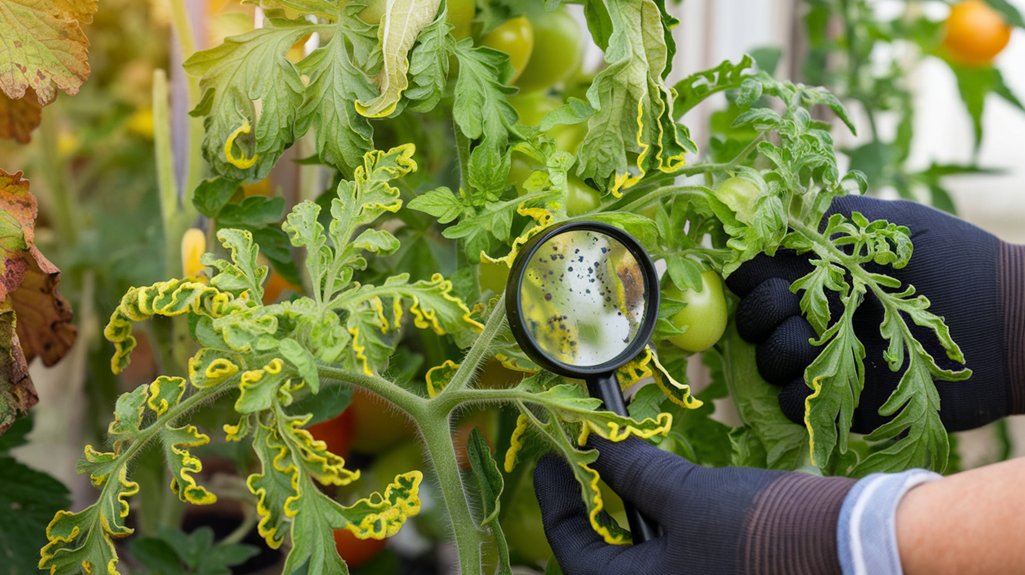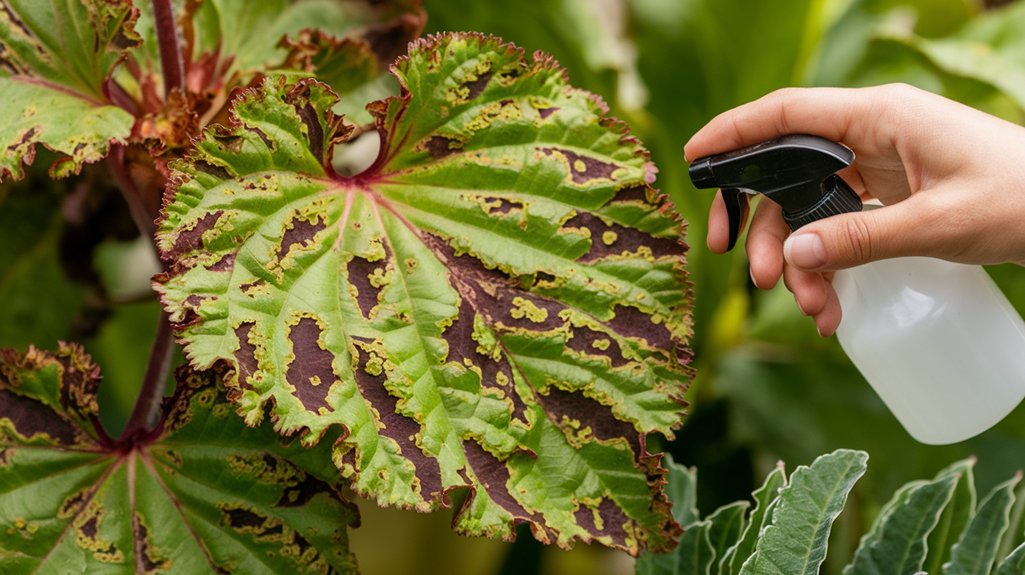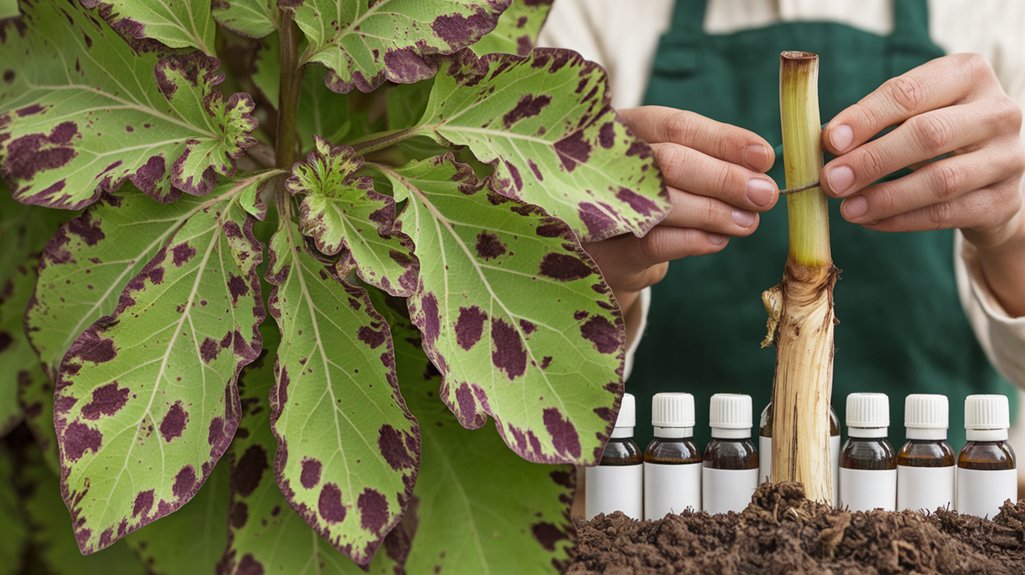As a plant enthusiast, you know that spotting issues early can save your garden. You might notice yellowing leaves or wilting stems and wonder what's going on. Understanding the signs of common plant diseases is crucial for maintaining health. But identifying these symptoms is just the beginning. Tackling the problem effectively requires knowledge of treatment options and preventative measures. Let's explore how to ensure your plants thrive despite potential threats.
Key Takeaways
- Regularly inspect plants for symptoms like yellowing leaves, wilting, or unusual spots to catch diseases early.
- Familiarize yourself with common fungal, bacterial, and viral diseases to recognize specific symptoms quickly.
- Apply appropriate fungicides or copper fungicides promptly after identifying fungal or bacterial infections.
- Remove infected plants and improve air circulation to prevent the spread of diseases and pests.
- Quarantine new plants before introducing them to your garden to avoid viral outbreaks.
Recognizing the Symptoms of Plant Diseases

Recognizing the symptoms of plant diseases is crucial for maintaining a healthy garden. You need to pay close attention to your plants, as early symptom recognition can prevent widespread issues.
Look for signs like yellowing leaves, wilting, or unusual spots, which can indicate various diseases. Identifying these symptoms quickly allows you to take action before the problem escalates.
Familiarize yourself with the common signs associated with different plant diseases, so you can react promptly. Checking for pests, irregular growth patterns, or changes in flowering can also provide clues for disease identification.
Common Fungal Infections and Their Treatment

Fungal infections are among the most common threats to plant health, and understanding how to identify and treat them is essential for any gardener.
Common fungal types include powdery mildew, root rot, and blight. You can spot powdery mildew by its white, powdery spots on leaves, while root rot often shows yellowing leaves and a foul smell from the soil.
To treat these infections, consider using fungicides specifically formulated for the type of fungus affecting your plants. You can also improve air circulation and avoid overwatering to prevent fungal growth.
Regularly inspect your plants and remove any infected parts to keep your garden healthy. With prompt attention and the right treatment methods, you can effectively manage fungal infections.
Understanding Bacterial Diseases in Plants

While fungal infections pose a significant threat to plants, bacterial diseases are another major concern for gardeners. Two common bacterial diseases you might encounter are bacterial wilt and leaf spot. Bacterial wilt can cause wilting and yellowing of leaves, leading to plant death, while leaf spot manifests as dark, water-soaked spots on foliage.
Here's a quick comparison of these diseases:
| Disease | Symptoms | Treatment |
|---|---|---|
| Bacterial Wilt | Wilting, yellowing leaves | Remove infected plants |
| Leaf Spot | Dark spots on leaves | Improve air circulation |
| Use resistant varieties | ||
| Apply copper fungicides | ||
| Monitor watering habits |
Being vigilant about these symptoms can help you maintain healthy plants.
Identifying Viral Infections and Their Impact
Viral infections can silently wreak havoc on your plants, often leading to significant crop loss if not identified early.
You'll notice symptoms like yellowing leaves, stunted growth, or unusual patterns on foliage. Understanding viral transmission is crucial; these pathogens often spread through insects, contaminated tools, or even infected hosts.
To prevent outbreaks, regularly inspect your plants for signs of distress and remove any infected hosts immediately. Quarantine new plants before introducing them to your garden, as they might carry hidden viruses.
Pest Infestations: Signs and Solutions
How can you tell if your plants are suffering from a pest infestation? Look for yellowing leaves, wilting, or unusual spots. You might notice tiny insects, webs, or sticky residue on your plants.
Understanding pest life cycles is crucial; pests often reproduce quickly, so early detection is key. Once you identify the issue, it's time for pest management. You can remove pests by hand, use insecticidal soap, or introduce beneficial insects like ladybugs.
Regularly inspect your plants to catch infestations early. Keep your garden clean and healthy to reduce pest attraction. By staying vigilant and proactive, you can protect your plants from damaging infestations and ensure their thriving growth.
Environmental Factors Affecting Plant Health
Understanding the environmental factors affecting plant health is essential for gardeners who want to maintain vibrant and resilient plants. Key aspects include light conditions, soil quality, and water availability. Temperature fluctuations and humidity levels can significantly impact growth, while nutrient deficiencies lead to weak plants. Adequate air circulation is crucial to prevent diseases, and seasonal changes can introduce new challenges.
| Factor | Importance | Potential Issues |
|---|---|---|
| Light Conditions | Affects photosynthesis | Stunted growth |
| Soil Quality | Provides nutrients and support | Poor root development |
| Water Availability | Essential for hydration | Wilting or root rot |
| Temperature Fluctuations | Influences metabolic processes | Stress and disease susceptibility |
Stay aware of these factors to ensure your plants thrive!
Preventative Measures for Healthy Plants
Maintaining healthy plants goes beyond just recognizing environmental factors; it involves taking proactive steps to prevent disease and stress.
Here are some effective measures you can take:
- Improve Soil Health: Regularly test and amend your soil to ensure it's rich in organic matter and microorganisms.
- Ensure Nutrient Balance: Use a balanced fertilizer to provide essential nutrients, avoiding deficiencies that weaken plants.
- Rotate Crops: Change the location of your plants each growing season to disrupt disease cycles and improve soil fertility.
- Water Wisely: Water at the base of plants early in the day to reduce moisture on leaves, minimizing fungal diseases.
Natural Remedies for Treating Plant Ailments
While it's crucial to prevent plant diseases, knowing how to treat them naturally can make a significant difference in your garden's health.
Start with herbal sprays that can deter pests and improve plant resilience. Compost tea is another great option, enriching the soil and promoting beneficial microbes.
If you face specific insect issues, consider using neem oil or insecticidal soap for targeted treatment. For fungal problems, a garlic solution and baking soda mix can act as effective natural fungicides.
Additionally, essential oils, like tea tree or eucalyptus, can help combat various ailments.
When to Seek Professional Help for Plant Diseases
Recognizing when to seek professional help for plant diseases can save you time and prevent further damage to your garden.
Here are four signs that indicate it's time to call in an expert for a professional diagnosis or emergency care:
- Rapid Spread: If a disease is spreading quickly among your plants, immediate action is essential.
- Unidentified Symptoms: When you can't pinpoint the cause of wilting, discoloration, or spots, professionals can help.
- Recurring Issues: Persistent problems that don't respond to treatments suggest a deeper issue that needs expert intervention.
- High-Value Plants: If your prized plants are at risk, seeking professional help can safeguard your investment.
Don't hesitate to contact a specialist when you see these warning signs!
Frequently Asked Questions
Can Indoor Plants Get Diseases Like Outdoor Plants?
Yes, indoor plants can get diseases just like outdoor plants. You should regularly check for indoor pests and practice disease prevention strategies to keep your plants healthy and thriving in your home environment.
How Can I Boost My Plant's Immunity Against Diseases?
To boost your plant's immunity against diseases, focus on disease prevention through proper watering and sunlight. You can also use natural remedies like neem oil or garlic spray to strengthen your plants and deter pathogens.
Are Certain Plants More Resistant to Diseases Than Others?
Absolutely, certain plant varieties exhibit greater disease resistance than others. When selecting plants, consider those known for their resilience, as they're less likely to succumb to infections and can thrive in various conditions.
What Role Does Soil Quality Play in Plant Health?
Soil quality significantly impacts plant health. You need to ensure your soil has adequate nutrients and the right pH level. Balanced soil nutrients promote growth, while proper pH helps plants absorb those nutrients effectively.
How Often Should I Inspect My Plants for Diseases?
You should inspect your plants at least once a week for disease symptoms. Regular inspections help you catch issues early, increasing your chances of successful treatment and keeping your plants healthy and thriving.
Conclusion
By keeping an eye out for signs of disease and acting quickly, you can protect your plants from harm. Remember to familiarize yourself with common infections and their treatments, and don't hesitate to use preventative measures to keep your plants healthy. If you notice persistent issues despite your efforts, reaching out to a professional can make all the difference. With a little vigilance and care, you can enjoy thriving, vibrant plants for years to come.
